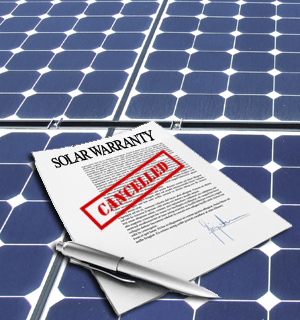For the past few weeks, we’ve covered some of the dangers of “poor” solar PV warranties in which manufacturers either won’t or can’t honor their promises to repair shoddy workmanship.
But it’s not enough to know that some solar PV panel warranties aren’t good. You also have to know how to spot these bad apples.
If only there was a magic formula.
You – the consumer – are faced with a sea of options, with no surefire way to test one technology against another – especially over 25 years (which is the standard length of most reputable solar PV panel warranties).
Although there’s no magic formula out there, you can glean some powerful insights from a little homework and background research. Below is a handy cheat-sheet to help you narrow down your list of options.
When Buying Solar Panels, Be Willing to Pay for Quality
Don’t make the mistake of focusing on cost and cost alone. I’ll admit, buying a new solar PV system isn’t the cheapest thing you’ll ever do – but if you buy a quality unit, it will be one of the smartest.
Remember that a good installation should last you at least 25 years – usually 30 or more. And over that time, your panels will generate kilowatt after kilowatt of free energy from the sun – enough to drive your electricity bills to $0 and maybe even put some extra cash in your pocket.
I promise you that you won’t be thinking about what you paid for your system 25, 10, or even 5 years from now. You’ll be thinking about how to spend the extra savings your system has brought you.
When Buying Solar PV Panels, Go with Trusted Names
If you haven’t heard of them – move on. There is no shortage of panel manufacturers on the market. But why reinvent the wheel by researching companies that haven’t already caught the attention of everyone else who came before you?
Now I’ll admit – sticking with trusted names is not a sure-fire way to avoid making mistakes. Chinese manufacturer Suntech, for example, is one of the largest and most trusted manufacturers on the planet. And yet, they’re going down even as we speak.
Which brings us to the next 2 points.
When Buying Solar PV Panels, Steer Clear of Chinese Producers
It’s a bit unfair to generalize – I know of many solid Chinese solar PV manufacturers. But for every good one, there are scores and scores of awful ones – simply awful.
Plus with the tariff wars and lack of oversight and foreign regulations – it’s best to steer clear of Chinese panels altogether. It’s harsh, but this one move can save you hours of research and untold sums of money.
When Buying PV Panels, Go with Vertically Integrated Producers
A vertically integrated solar PV manufacturer is one who controls a huge portion of its supply chain. In other words, it handles much of the extraction, processing, manufacturing, and assembling in-house (or through subsidiaries).
The benefit of vertical integration is that the manufacturer protects itself from rapid changes in pricing. This is what ultimately got Suntech in trouble. Silicon prices fell so much – so quickly – that this non-vertically integrated, Chinese solar manufacturer was unable to meet its financial obligations.
A few years ago, vertical integration wasn’t as important. In fact, we carry (and will continue to carry) a number of high quality solar PV panels made by manufacturers that are not vertically integrated. Our confidence in these products is very high, and we see no reason to change.
But if you’re starting from scratch, vertical integration can be a useful indicator.
When Buying Solar Panels – Ask the Experts
This last one is a real time-saver, but you can always just ask an expert.
At USSolar Institute and Florida Solar One, all we do – all day – is buy, sell, install, and train how to install solar PV equipment.
We’re happy to answer any questions you have about solar PV warranties. So never hesitate to ask.
And if you’re thinking about installing a new system but can afford to wait, you might want to check out our upcoming “Real-World Solar PV Challenge” in which we do side-by-side comparisons of some of the leading technologies on the market. Click here to learn more about the Challenge.
Originally Posted on Florida Solar One

